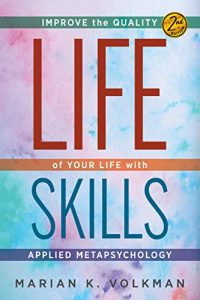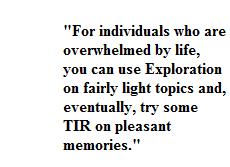This article originally appeared in the TIR Association News & Views Newsletter, Vol. III, No. 3 (October 1999)

If you enjoy this article, we recommend you check out Life Skills: Improve the Quality of Your Life with Metapsychology available from www.TIRBook.com
Let us first take a look at the gradient of techniques from easiest for the viewer (client) to do, to the most challenging. It is much easier to increase the gradient of difficulty with a client than it is to bail out from a too difficult technique. Simple Exploration[1] is the least demanding of all techniques for the client. Ironically, it is one of the most demanding for the facilitator (practitioner) because, unlike techniques with set questions, which are used repetitively in a pattern, such as Unblocking (a technique for thoroughly addressing life issues such as self esteem or relationships) and TIR (Traumatic Incident Reduction), Exploration has no set questions at all. The facilitator must be nimble enough to keep thinking up new relevant questions in the moment, while still maintaining the Rules of Facilitation (the rules of practice that ensure the safety, precision, and high level of effectiveness of TIR and related techniques). Of course all therapists and counselors make use of these skills, and must have command of them in order to get results with their clients. However, doing Exploration as a technique within a purely person-centered framework offers special challenges and is a skill in itself.
When in doubt, always start with Exploration. If a traumatic incident presents itself and your client is eager to address it, by all means do so, but if you are not exactly sure whether an area of interest to the client would be best addressed by using TIR, Unblocking or another technique, start by doing some Exploration to get a fuller picture. Sometimes you will find an issue will resolve completely just with Exploration alone.
Next on the gradient is Unblocking. It asks the viewer to look at an area in a variety of ways but it is a gentle technique in that, if there are no answers to a question, you just move on to the next one. This technique is very productive, given that you have chosen a fruitful area to address; and it is easy on both the facilitator and the viewer, allowing each to work steadily without having to contemplate where to go next.
A refinement on the use of Unblocking from the case planning standpoint is to make a list of possible topics around a subject that has come up in order to be sure of getting the most productive wording to address. For instance, if your client comes in with difficulties about their job you could just do Unblocking, “Concerning your job, is there anything that has been ________?”
Fine-Tuned Unblocking
The more thorough way to approach the subject is this:
- Make a list such as: “Your job, your work environment, your boss (or your employees, depending on which fits the situation), your productivity, your success at work, your abilities at work.” Make up this list before the session, when you are doing your case planning. Choose the items that seem to fit this client’s situation. Do use words and phrases the client has mentioned, especially if they have come up on a few occasions.
- Read this list to your client.
- Ask him/her to add any phrases that belong on the list. (This is often where you get the most useful items to address.)
- Out of all the potential items you now have on the list, ask the viewer to pick the item which seems the most interesting for the purpose of bringing about clarity on the subject. Take the one they give you and do Unblocking on it.
- Once you have reached an end point (the point at which the viewer is fully satisfied that issue has been dealt with) on that action, check the list to see if there is another item which now attracts their interest to address with Unblocking. You may run out of items which have enough emotional charge and interest to warrant Unblocking, but are of sufficient interest that Exploration on them is useful. Determine this by consulting with your client.
Remedies
A number of light Remedies for various situations can be employed wherever they are needed. A distraught client or one with acute pain can benefit from Remedies. See the book Life Skills: Improve the Quality of Your Life with Applied Metapsychology, Second Edition.
The next gradient is repetitive Recall techniques, such as the one at the back of the basic TIR Workshop Manual (Positive Recall List). Within this category, recalling something pleasant is a lighter gradient than recalling something more challenging. Handling Disturbances[2] (Upsets; Problems; Withheld Communication) is intended to be a fairly light technique, but it does require the client to look at events in a very detailed way. Since quite a number of earlier similar events may need to be found and handled as well, Disturbance Handling may present more of a challenge to the viewer than the techniques covered up to this point.
A special application of Disturbance Handling is to explore and handle Disturbances in a particular area. For instance: “At work have you had an upset?” (If so, handle it.) Then, “Is there another upset you have had at work?” etc., until all upsets in the area are handled. Then, “At work have you had a problem?” (As above) and “At work have you withheld some communication?” (As above).
Between Basic TIR (addressing a known, specific traumatic Incident) and Thematic TIR (addressing sequences of traumatic incidents linked by a common feeling or “theme”), theoretically the Basic application is easier on the client, as he is dealing with a known incident and the technique often goes to an End Point within the context of addressing that one incident without having to go earlier to find another one. In Thematic TIR, since the client is starting with a feeling rather than an incident, they must go looking for incidents. We expect them to need to look for a number of earlier incidents with the common theme in order to reach an end point. Accordingly, case supervisors tend to write case plans which emphasize Basic TIR early on and don’t bring in Thematic TIR until later.
As long as your client is up to the demands of TIR in the first place, however, they will probably do fine with Basic, Thematic, or Future TIR[3]. It’s more important that you use the right tool to do the job at hand than that you be too strict about which TIR application to use in which order.
The Overwhelmed Viewer
 For chronically overwhelmed viewers only the lightest methods should be used in short sessions to build up their resilience. An example of this would be starting each session with an Orientation Remedy (to a point of the client feeling more present and stable); a Touch Remedy (to make the person feel more comfortable in their body); some Exploration on fairly light topics; and eventually one could try some TIR on pleasant memories. This last is helpful for building up the confidence of someone who feels buffeted by life. You explore to find a specific pleasant memory, then use the TIR steps as you would in Basic TIR to an end point of your client brightening up and moving attention from the past to the present, from an inward focus to an outward one.
For chronically overwhelmed viewers only the lightest methods should be used in short sessions to build up their resilience. An example of this would be starting each session with an Orientation Remedy (to a point of the client feeling more present and stable); a Touch Remedy (to make the person feel more comfortable in their body); some Exploration on fairly light topics; and eventually one could try some TIR on pleasant memories. This last is helpful for building up the confidence of someone who feels buffeted by life. You explore to find a specific pleasant memory, then use the TIR steps as you would in Basic TIR to an end point of your client brightening up and moving attention from the past to the present, from an inward focus to an outward one.Regardless of whether a viewer is experienced and working well in sessions, just getting started with viewing, or overwhelmed, the values of having a written case plan are that it makes your job as a facilitator much easier and it keeps you from forgetting to cover an area of client interest and concern. The broader subject of Applied Metapsychology, of which TIR and its related subjects are a part, contains a wealth of further techniques and case planning strategies.
Footnotes
1 Exploration: A relatively informal viewing technique in which the facilitator asks questions to get the viewer to look at and talk about different items and records the answers given. Exploration may be done as a separate interview or as part of a viewing session.
2 Handling Disturbances (upsets, problems and worries, misdeeds, withheld communication) is taught on the TIR Workshop, the TIR – Expanded Applications Workshop and the Life Stress Reduction Workshop.
3 Future TIR is taught in the TIR – Expanded Applications Workshop. Future TIR can be used when a viewer’s attention is fixed on events that have not occurred yet, but that s/he is sure will occur or that s/he is afraid will occur.
4 Remedies are Applied Metapsychology techniques developed for the specific purpose of providing immediate help to someone who has had a physical or emotional shock. Remedies can be found in Appendix One in the textbook Psychology: An Introduction to Metapsychology by Frank A. Gerbode, MD, and in Life Skills: Improve the Quality of Your Life with Applied Metapsychology by Marian Volkman. See www.tirbook.com.
